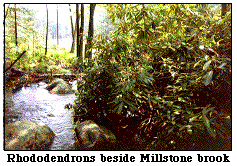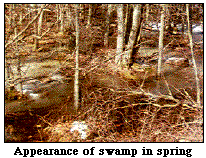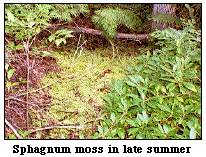A casual glance at the forested 800+ acres comprising the Hackett Hill property would reveal little about its biological value. However a number of biological surveys concerning this area are available - two "Senior Projects" done by UNH interns in 1995 and 1998; a 1993 wildlife management plan by Jon Nute, forester at the UNH Extension Service; and portions of two extensive studies performed in 1991-1992 and 1993 by the New Hampshire Natural Heritage Inventory, Department of Research and Economic Development, under the auspices of the New Hampshire Nature Conservancy. These reports provide considerable information about the living components of the property and reveal that it has many unique qualities.
The most noteworthy feature of the Hackett Hill area is that it contains numerous large and small wetlands. (SEE MAP) In the past, wetlands clearly did not get the attention that they deserve, but at present the public is generally well-informed of their importance. These areas not only provide habitat for various forms of wildlife, but also help in flood control and are involved with water purification, and are thus worthy of protection by legislation.
The Hackett Hill wetlands are primarily forested wetlands, or swamps, which have been described as "unusual" by biologists. Here, Atlantic white cedar, black gum, and red maple trees are found. In some instances giant rhododendrons (Rhododendron maximum) and swamp azaleas (Rhododendron viscosum) grow in close proximity to the trees. The two rhododendron species, as well as a species of goldenrod found elsewhere on the property, have been designated as "threatened" species because of their rarity, and a butterfly which is typically found in Atlantic white cedar swamps has been designated as an endangered species.
The general appearance of the swamps is definitely seasonal in nature. As the snow melts in the spring, water levels are quite deep. At this time individual "hummocks"- elevations which protrude somewhat above water level are well defined and a person who wants to traverse the swamp can jump from hummock to hummock. Generally one-three trees grow close together on each hummock.
Towards the end of summer, and as fall commences, water levels decline, and the spaghnum moss covering the floor of the swamp resembles a thick green carpet. At these times, the ATLANTIC WHITE CEDAR SWAMPS and the BLACK GUM SWAMPS are more accessible, and their unusual beauty can be fully appreciated.
In addition to wetlands, the property
includes forested uplands and open water . In most cases, hardwoods
predominate, mostly white oak and red  oak,
with mature white pine found alongside Millstone Brook in the
northeastern part of the forest. Colonies of giant rhododendrons also
may be found alongside the brook and in a few locations in the upland
regions.
oak,
with mature white pine found alongside Millstone Brook in the
northeastern part of the forest. Colonies of giant rhododendrons also
may be found alongside the brook and in a few locations in the upland
regions.
Familiar types of wildlife which are found on the property include coyotes, porcupines, foxes, rabbits, chipmunks, mice, raptors such as hawks and owls, and numerous other bird species. Recently, there has been much interest in DEER and MOOSE which are Hackett Hill dwellers.
Ponds are located adjacent to Millstone Brook and provide typical beaver habitats. Vernal pools, which play important roles in the life cycle of many invertebrates and amphibia, are scattered throughout the property.
At present, development on the Hackett Hill property is limited to the French Hall region, the "infrastructure" for the proposed extension of the campus, and right-of-way power lines owned by the Public Service Company of New Hampshire.

